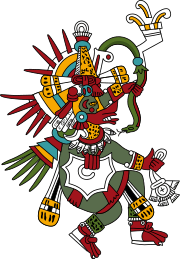Tlazolteotl

In Aztec mythology, Tlazolteotl (or Tlaçolteotl, Nahuatl pronunciation: [tɬasoɬˈteotɬ]) is a goddess of purification, steam bath, midwives, filth, and a patroness of adulterers. In Nahuatl, the word tlazolli can refer to vice and diseases. Thus, Tlazolteotl was a goddess of filth (sin), vice, and sexual misdeeds. However, she was a purification goddess as well, who forgave sins and cured diseases caused by misdeeds, particularly sexual misdeeds.[1] Her dual nature is seen in her epithets; Tlaelquani ('she who eats filth [sin]') and Tlazolmiquiztli ('the death caused by lust'), and Ixcuina or Ixcuinan ('she of two faces').[2][3] Under the designation of Ixcuinan she was thought to be plural in number and four sisters of different ages by the names Tiacapan (the first born), Teicu (the younger sister), Tlaco (the middle sister) and Xocotzin (the youngest sister).[3]
Her son was Centeotl and she was also known as Toci. She presides over the 13th trecena of the sacred 260-day year. Another son is Yum-Kax, the Maya maize god.[4]
Aztec religion

Tlazolteotl may have originally been a Huaxtec goddess from the Gulf Coast.[1] In the Aztec religion there were two main deities thought to preside over confession: Tezcatlipoca, because he was thought to be invisible and omnipresent, seeing everything; and Tlazolteotl, the goddess of lechery and unlawful love.[5] It is said that when a man confessed before Tlazolteotl everything was revealed. Confession to Tlazolteotl would be done through a priest but, unlike the Christian practice, it happened only once during a man's lifetime.
According to Aztec belief, it was Tlazolteotl who inspired vicious desires, and who likewise forgave and cleaned away the defilement of sin.[5] She was also thought to cause disease, especially sexually transmitted disease. It was said that Tlazolteotl and her companions would afflict people with disease if they indulged themselves in forbidden love.[6] The uncleanliness was considered both on a physical and moral level, and could be cured by steam bath, a rite of purification, or calling upon Tlazolteteo, the goddesses of love and desires.[6]
Dirt eating
Tlazolteotl was called "Goddess of Dirt" (Tlazolteotl) and "Eater of Ordure" (Tlaelquani, 'she who eats dirt [sin]'), with her dual nature of goddess of dirt and also of purification. Sins were symbolized by dirt. Her dirt-eating symbolized the ingestion of the sin of those who confessed, and in doing so purified it.[7][8] She was depicted with ochre colored symbols of divine excrement around her mouth and nose.[8] In the Aztec language the word for sacred, tzin , comes from tzintli, the buttocks, and religious rituals include offerings of "liquid gold" (urine) and "divine excrements", which Klein jocularly translated to English as "holy shit".[8][9]
She had the function of creating harmony again in the community.[8]
Festival
Tlazolteotl was one of the primary Aztec deities celebrated in the festival of "Ochpaniztli" (meaning "sweeping") that was held September 2–21 to recognize the harvest season. The ceremonies conducted during this timeframe included ritual cleaning, sweeping, and repairing, as well as the casting of corn seed, dances, and military ceremonies.[10]
See also
Notes
- 1 2 Miller & Taube, p.168
- ↑ Soustelle, p.104,199
- 1 2 Sahagun, Florentine codex book 1, p. 23
- ↑ http://www.crystalinks.com/aztecgods.html
- 1 2 Soustelle, p.199
- 1 2 Soustelle, p.193
- ↑ Thelma D. Sullivan (1982) Tlazolteotl-Ixcuina: The Great Spinner and Weaver. p.15
- 1 2 3 4 Gonzales, Patrisia (2012) Red Medicine: Traditional Indigenous Rites of Birthing and Healing pp.98-9 quotation:
Klein reinterprets the ochre color symbols found around the mouth and nose of some Tlazolteotl depictions, as well as painted to represent matter emanating from the buttocks-from connoting "dirt" to "divine excrement." She notes that tlazolli-interpreted by many academics as Tlazolteotl's root word-is not only excrement or something old or used. Similarly the word for "venerable" is tzin, which comes from tzintli, the buttocks. Urine as "liquid gold" and offerings of excrement are examples of "divine excrement" or, as Klein writes playfully, "Holy Shit."
- ↑ Klein, Cecelia F. (1993) Teocuitlatl, 'Divine Excrement': The Significance of 'Holy Shit' in Ancient Mexico, in Art Journal (CAA), Vol.52, n.3, Fall 1993, pp.20-7
- ↑ Townsend, p.221
References
| Wikimedia Commons has media related to Tlazolteotl. |
- Soustelle, J., (1961) The Daily life of the Aztecs, London, WI
- An Illustrated Dictionary of the Gods and Symbols of Ancient Mexico and the Maya, by Mary Miller & Karl Taube Publisher: Thames & Hudson (April 1997)
- Bernardino de Sahagun, 1950–1982, Florentine Codex: History of the Things of New Spain, translated and Edited by Arthur J.O. Anderson and Charles Dibble, Monographs of the school of American research, no 14. 13. parts Salt Lake City: University of Utah Press
- Townsend, R.F., (2000) The Aztecs Revised Edition, Thames & Hudson Ltd, London
